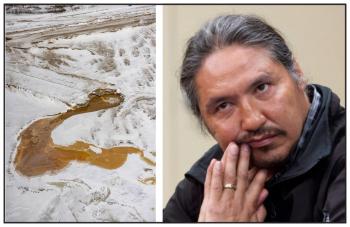Image Caption
Summary
Local Journalism Initiative Reporter
Windspeaker.com
“Environmental racism” is one reason being offered by Athabasca Chipewyan First Nation (ACFN) Chief Allan Adam as for why both the Alberta Energy Regulator (AER) and Imperial Oil Resources kept silent about tailings pond seepage that began mid last year from Kearl Oil Sands Processing Plant and Mine site.
“Because we’re a small community, small First Nations, living up north, we’re not considered to be…humans, I guess. Is that why they didn’t tell us about the danger and the seepage and everything? We’re not considered human beings or we’re just considered to be livestock?” said Adam in news conference March 2. “Is it going to be like this forever? Environmental racism? Is that what you want to call it?”
The ACFN was only notified after AER issued an environmental protection order (EPO) on Feb. 6. At least 5.3 million litres of toxic chemicals overflowed Feb. 4 from a dam at the Kearl mine into the environment and upstream of Fort Chipewyan.
Adam contended that had the overland spill not occurred both AER and Imperial Oil, which operates the Kearl mine, would have remained silent about seepage into the watershed. The EPO contained information of earlier damage.
According to the EPO, Imperial first reported the seepage to AER on May 19, 2022. There were four seepage sites, including one in close proximity to Waterbody 3, which is fish-bearing, and has tributaries that feed the Firebag and Muskeg rivers.
In August, monitoring results confirmed the spillage as industrial wastewater, which contained amounts of dissolved iron, total arsenic, F2 hydrocarbons, sulfate and total sulfide in amounts exceeding the regulatory guidelines for the protection of aquatic life.
When AER issued a notice of non-compliance to Imperial “for failing to manage and contain the industrial wastewater” in September 2022, ACFN was still not notified of the environmental concerns.
Adam said had such a seepage occurred in Edmonton or Calgary, AER and Imperial would have issued notifications immediately.
Since learning of the leaks, ACFN has informed their members, many of which subsistence hunt, fish and gather in the region, to not eat what they’ve collected since May 2022.
Adam said a study a “few years back” indicated that 78 per cent of people in Fort Chipewyan still harvested from the land. He said figures that indicated how much food was harvested from the Kearl area were not available.
Members have been asked to bring their frozen food from the area in for testing, said Callie Davies-Flett, ACFN regulatory advisor for the Dene lands and resource management group. They are still awaiting results from the ongoing tests.
Davies-Flett noted that in a fly-by of the site that she participated in on Feb. 28, three moose were spotted within 100 metres of the leak.
Water supply for Fort Chipewyan is no longer being drawn from the Athabasca River, but instead is being taken from reservoir waters until further testing can be conducted, added Davies-Flett.
ACFN has also sought and received approval from Imperial, in accordance with a mutual agreement between the two parties, to send ACFN community environmental monitors to the site to collect samples.
“At this point in time, it’s going to be hard for me to believe anything that comes out of the representatives from the Imperial site and the AER as well. The only one that we could count on now is our own community-based monitoring program to go in there and assess the damage that’s already occurred,” said Adam.
Adam said it was unclear how long it would take for the full impact of the seepage and spill to be assessed. He noted that the “true extent” of the tailings pond spill in 2013 from the Obed Mountain Mine into the Athabasca River is only being realized today. Approximately 670 million litres of water containing tonnes of sediment and coal fines breached an earth berm and flowed into the Apetowun and Plante creeks, entering the Athabasca River.
Adam said ACFN had a number of meetings with Imperial in November and instead of representatives informing them of what had happened, they “chose to hide the facts.”
Adam is calling on the federal departments of Fisheries and Oceans as well as Environment to investigate the mine and to stop Imperial from operating Kearl until the issues have been dealt with.
"The failure of one pond might be explained as a malfunction, but the failures of four ponds suggests much bigger problems at the Kearl site. And these are just the ones we know of. ACFN is concerned that Imperial may not have adequate procedures or infrastructure to contain their tailings,” said Adam.
Also on the table is possible legal action against AER “for failure to communicate and report this to the downstream communities and the Indigenous people,” said Adam, although he added it was still too early to determine if that action will be taken.
Never miss a Windspeaker article. Subscribe Today to our new Windspeaker Newsletter!
Local Journalism Initiative Reporters are supported by a financial contribution made by the Government of Canada.

